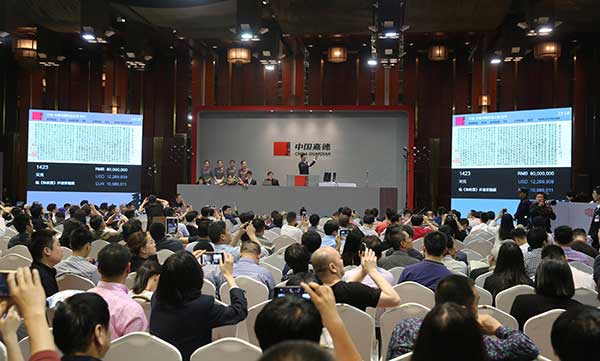
The Grand View sale of Chinese painting and calligraphy on May 15 generates several high prices, including 92 million yuan for Ming Dynasty calligrapher Song Ke's album.(Photo provided to China Daily)
The Grand View sale of old Chinese artworks made 667 million yuan, exceeding the modern art total for the first time since the sale's launch
On May 15, the Grand View night sale of Chinese paintings and calligraphy, staged twice a year by Beijing-based China Guardian Auctions, saw a packed salesroom. So those who arrived late had to stand in the back. When the first part of the sales event - comprising modern works - ended, many walked out of the room, leaving dozens of empty seats.
But that meant the most exciting part of the auction was just about to get started.
The second section, comprising classical works, typically referring to pieces produced during and before the Qing Dynasty (1644-1911), generated three big transactions that night.
Jushi Tie, a letter by Song Dynasty (960-1279) politician Zeng Gong, grossed 207 million yuan ($31 million); a calligraphy album in caoshu (a running script) by Ming Dynasty (1368-1644) calligrapher Song Ke sold for 92 million yuan and an album of calligraphed Buddhist sutras, poems and paintings by Tang Dynasty (AD 618-907) and later scholars fetched 57.5 million yuan.
In the classical art section - where 15 of the total of 45 pieces remained unsold - the total takings were 667 million yuan, exceeding the modern art takings for the first time since the Grand View sale was launched in 2011.
The results of the Grand View sale reinforce the impression that the market for classical Chinese art, which has been stable over the past decade, is growing.
The classical Chinese art market is becoming bigger slowly even as other categories, including contemporary art and modern Chinese paintings and ceramics that used to produce record prices in the boom years around 2008, have continued to slide.
This is because of sluggishness in the Chinese art market since 2014 as the country's economy cools, driving away buyers looking for quick profits.
Jushi Tie was sold to Chinese media mogul Wang Zhongjun and the buyer of Song Ke's album is Zhang Xiaojun from Shanxi province. Both are avid collectors of contemporary art, and hence their successful bids were seen as surprising.
But Beijing-based art market expert Ji Tao said in a recent blog that collectors are diversifying their purchases, and the successful bids by Wang and Zhang indicate that due to a shortage of quality contemporary works, they are now looking at other genres such as classical pieces that are rarely seen on the market yet boast a sound provenance and are cataloged in important inventories compiled by academic authorities.


















































